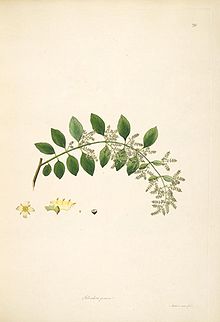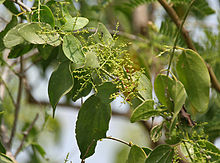- Salvadora persica
-
Salvadora persica 
Scientific classification Kingdom: Plantae Division: Magnoliophyta Class: Magnoliopsida Order: Brassicales Family: Salvadoraceae Genus: Salvadora Species: S. persica Binomial name Salvadora persica
Wall.Salvadora persica (Arak, Galenia asiatica, Meswak, Peelu, Pīlu, Salvadora indica, or toothbrush tree, mustard tree), is a species of Salvadora.[1][2] Salvadora persica has antiurolithiatic properties.[3] Used for centuries as a natural toothbrush, its fibrous branches have been promoted by the World Health Organization for oral hygiene use. Research suggests that it contains a number of medically beneficial properties including abrasives, antiseptics, astringent, detergents, enzyme inhibitors, and fluoride.[4][5][6][7][8][9]
Contents
Appearance
Salvadora persica is a small tree or shrub with a crooked trunk, seldom more than one foot in diameter. Its bark is scabrous and cracked, whitish with pendulous extremities. The root bark of the tree is similar to sand, and the inner surfaces are an even lighter shade of brown. It has a pleasant fragrance, as well as a warm and pungent taste. It sheds its leaves from late December to January. The leaves break with a fine crisp crackle when the foot falls over them. In Pakistan these ancient, majestic and sturdy trees are more closely associated with graveyards like the cypress tree in English culture.
History and use
Salvadora persica is a popular chewing stick throughout the Indian subcontinent, as well as the wider Muslim world.[11] Also commonly referred to as miswak, it is often mentioned that the Islamic Prophet Muhammad recommended its use. He is quoted in various Hadith extolling the twig's virtues.[12]
As of 2009, Botanic Gardens Conservation International has a total of eight Salvadora persica plants in conservation.[13]
Scientific analysis
According to chemical and phytochemical analysis of Salvadora persica, there was an occurrence of carbohydrates and/or trimethylamine; an alkaloid which may effectively be salvadorine; chlorides; sulfur; terpenes; vitamin C; glycosides; large amounts of fluoride and silica; small amounts of tannins, saponins, flavonoids and sterols.[14][15]
See also
References
- ^ "Salvadora persica". World Agroforestry Centre. http://www.worldagroforestrycentre.org/Sea/Products/AFDbases/AF/asp/SpeciesInfo.asp?SpID=1477. Retrieved 2009-02-16.
- ^ "Salvadora persica". Food and Agriculture Organization of the United Nations. http://www.fao.org/docrep/x5327e/x5327e1j.htm. Retrieved 2009-02-16.
- ^ Geetha K, Manavalan R, Venkappayya D.,"Control of urinary risk factors of stone formation by Salvadora persica in experimental hyperoxaluria." Exp Clin Pharmacol. 2010 Nov;32(9):623-9
- ^ Almas, Khalid (2002-08-15). "The Effect of Salvadora Persica Extract (Miswak) and Chlorahexidine Gluconate on Human Dentin: A SEM Study". Journal of Contemporary Dental Practice 3 (3): 27–35. PMID 12239575. http://www.thejcdp.com/issue011/almas/almas.pdf. Retrieved 2009-02-16.[dead link]
- ^ Amro, Soliman; Hatem E. Amin, Mohammed Batwa (May 2007). "Oral hygiene and periodontal status associated with the use of miswak or toothbrush among Saudi adult population". Cairo Dental Journal 23 (2): 159–166. http://dentistry.cu.edu.eg/Cairo%20Dental%20Journal/159-166-6.pdf. Retrieved 2009-02-16.[dead link]
- ^ Batwa, Mohammed; Jan Bergström, Sarah Batwa, Meshari F. Al-Otaibi (2006). "Significance of chewing sticks (miswak) in oral hygiene from a pharmacological view-point.". Saudi Dental Journal 18 (3): 125–133. http://www.sdsjournal.org/2006/volume-18-number-3/2006-18-3-125-133-full.html. Retrieved 2009-02-16.
- ^ Araya, Yoseph (2008-04-15). "Contribution of Trees for Oral Hygiene in East Africa". Ethnobotanical Leaflets 11: 38–44. http://www.siu.edu/~ebl/leaflets/araya.htm. Retrieved 2009-02-16.
- ^ Spina, Mary (1994-04-28). "Toothbrushes - the Miswak Tree" (TXT). University at Buffalo Reporter 25 (26). http://www.buffalo.edu/ubreporter/archives/vol25/vol25n26/10b.txt. Retrieved 2009-02-16.
- ^ Al-Sadhan, Ra'ed; Khalid Almas (1999). "Miswak (chewing Stick): A Cultural And Scientific Heritage" (PDF). Saudi Dental Journal 11 (2): 80–87. http://www.sdsjournal.org/downloads/task,doc_download/gid,439. Retrieved 2009-02-17.[dead link]
- ^ S. Abid Hussain, Associate Professor of English, Govt.Degree College No.1, Dera Ismail Khan/Pakistan
- ^ National Institute of Industrial Research (2003). Herbs Cultivation & Their Utilization. Delhi: Asia Pacific Business Press. pp. chapter 2. ISBN 978-8178330648.
- ^ IslamKotob, Muslims and Science, (Islamic Books), p.30.
- ^ "Botanic Gardens Conservation International - PlantSearch database". http://www.bgci.org/plant_search.php?action=Find&ftrGenus=Salvadora&ftrRedList=&ftrSpecies=persica&ftrRedList1997=&ftrEpithet=&ftrCWR=&x=0&y=0.
- ^ Akhtar, M.S.; M. Ajmal (April 1981). "Significance of chewing-sticks (miswaks) in oral hygiene from a pharmacological view-point.". Journal Pakistan Medical Association 31 (4): 89–95. PMID 6785501.
- ^ Ahmed, Salah; Soaad Esmaeil Essawy El-Gengaihi, Mohamed El-Sayed Ibrahim, Ewald Schnug (2008). "Preliminary phytochemical and propagation trial with Salvadora persica L." (PDF). Agriculture and Forestry Research 1/2 (58): 135–138. http://cairo.daad.de/imperia/md/content/kairo/wissenschaftsjahr/biotech_abstract6. Retrieved 2009-02-16.
External links
- Salvadora persica at the Food and Agriculture Organization of the United Nations
- Salvadora persica at the World Agroforestry Centre
- Salvadora persica in West African plants - A Photo Guide.
Gallery
-
in Krishna Wildlife Sanctuary, Andhra Pradesh, India.
-
in Krishna Wildlife Sanctuary, Andhra Pradesh, India.
Categories:- Salvadoraceae
- Trees of Africa
- Flora of the Sahara
- Flora of Morocco
- Flora of Northern Africa
- Shrubs
- Medicinal plants
Wikimedia Foundation. 2010.



